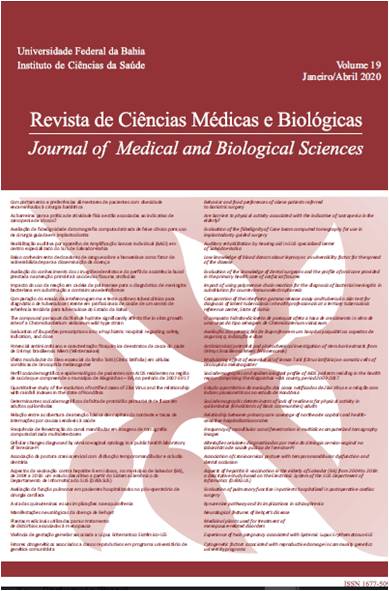Cellular changes diagnosed by cérvico-vaginal cytology in a public health laboratory of Teresina-PI
DOI:
https://doi.org/10.9771/cmbio.v1i1.31996Resumo
Objective: to verify the frequency of cellular alterations of the female genital tract of women assisted by a public clinical laboratory in Teresina – Piaui in 2016, as well as to evaluate the relation between patients’ education levels and the frequency of atypia found. Methodology: data from the 9040 forms of cervical-vaginal oncocytology (SUS standard) from the 2016 year were collected. Results: 9040 reports were analyzed, among which 8,095 (89.55%) had negative and 945 (10.45%) were positive to oncologic abnormalities. It was identified squamous cells of indeterminate significance with 5.84%, low-grade intraepithelial lesions (LSIL) with 1,97%, high-grade intraepithelial lesions (HSIL) 1.33%, glandular cell atypia (ACG) with 1.25% and invasive squamous cell carcinoma 0.06%. Regarding the level of schooling, women who attended elementary and high school corresponded to the higher percentage of patients. Conclusion: it is concluded that the incidence of atypia was considerably higher than described in the previous literature. Thus, it is recommended the adoption of strategies to improve the adherence and the awareness of the population regarding the necessity of this exam.Downloads
Não há dados estatísticos.
Downloads
Publicado
2020-06-17
Como Citar
Cavalcante, G. L., Teixeira, S. C., Brandim, S. R. P., Moura, M. C. L. de, Pires, Y. M. da S., & Nascimento, P. P. do. (2020). Cellular changes diagnosed by cérvico-vaginal cytology in a public health laboratory of Teresina-PI. Revista De Ciências Médicas E Biológicas, 19(1), 104–108. https://doi.org/10.9771/cmbio.v1i1.31996
Edição
Seção
Artigos originais
Licença
Copyright (c) 2020 Revista de Ciências Médicas e Biológicas

Este trabalho está licenciado sob uma licença Creative Commons Attribution 4.0 International License.
A Revista de Ciências Médicas e Biológicas reserva-se todos os direitos autorais dos trabalhos publicados, inclusive de tradução, permitindo, entretanto, a sua posterior reprodução como transcrição, com a devida citação de fonte. O periódico tem acesso livre e gratuito.






